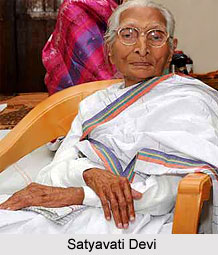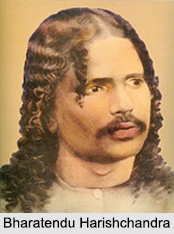 Satyavati was a heroic figure of the National liberation movement. She was a living saga who fought for the noble cause of bringing the women of Delhi out of their homes to participate in the freedom struggle. At those times men was reluctant to let women to participate in activities outside their homes. Men were of the view that women only knew household chores. Satyadevi shook the citadels of orthodoxy and conservatism and bought women out of their homes and had shown men that women can no longer be regarded as mere goods and chattels. Satyavati lit in their hearts the torch of burning love of patriotism. Women from Delhi`s orthodox communities came in large numbers to listen to her speeches. Satyavatl became a legend in her brief lifetime.
Smt. Satyavati Devi was the grand daughter of Swami Shraddhanand. She was the foremost woman leader of Delhi of those years. Her fiery oration and remarkable capacity for organization drew women to join the Satyagraha campaigns. Satyavati electrified the atmosphere with her eloquent speeches. She was married to an officer of the Delhi Cloth Mills and had one son and a daughter. One of them was a suckling infant whom she had to carry to jail at the time of one of her imprisonments.
Satyavati set up the Congress Mahila Samaj and the Congress Desh Sevika Dal. Women from all walks of life and all corners of Delhi were attracted by her sincerity and passionate patriotism. Later Satyavati became one of the founder members of the Congress Socialist Party. She wanted to enlighten the Delhi`s textile workers and make them politically conscious
Satyavati`s magnetic personality attracted students, both boys and girls, especially of the Hindu College and the Indraprastha Girls High School and College. These students organized groups of housewives who had never before taken part in public demonstrations and the like.
During the Salt Satyagraha, Satyavati and her colleagues decided to assemble in Delhi at a marshy vacant plot in the Shahdara suburb, where the salt content of the sub-soil water was high. Fifty of them made salt in defiance of .the salt laws. This went on for about ten days. Packets of salt were prepared and distributed freely. The Delhi police dispersed the volunteers, who had organized the Salt Satyagraha. This was the beginning of the Civil Disobedience Movement in Delhi. The officials became ruthless in their methods of oppression. Lathi Charges, firing on processions, imprisonment, prohibiting gatherings, collective fines and taking away of properties became the order of the day. Every act of repression hardened the Satyagrahis. Women became the important participants in the movement side by side with men. Many of them were married when they were adolescents and some were widowed at an early age. Therefore, when women who were just housewives stepped out of their homes and faced lathi charges and firings, people were filled with wonder and admiration. The men of Delhi in particular, were amazed at the courage shown by women who had been known for their docility and passiveness. As the struggle for freedom progressed, Indian women plunged into the struggle all over the country and thereby earned the right to be free and equal with men. The credit goes to Satyadevi alone, else women would have remained forever as the slaves of men preparing food and looking after them.
Satyavati had to undergo imprisonment many times. Frequent jail going and the hard life made her a victim of tuberculosis. Despite the serious illness, her spirit was not subdued. Satyavati ignored the advice of doctors and went on defying every tyrannical assault of the British authorities. Satyavati continued to guide her fellow-workers at Delhi from her sick bed. Her hectic and ceaseless activity brought about an untimely end to her life in 1945 when she was only 41.News of Satyavati`s death shocked Delhi. She will ever remain in the hearts of all Indians.
Satyavati was a heroic figure of the National liberation movement. She was a living saga who fought for the noble cause of bringing the women of Delhi out of their homes to participate in the freedom struggle. At those times men was reluctant to let women to participate in activities outside their homes. Men were of the view that women only knew household chores. Satyadevi shook the citadels of orthodoxy and conservatism and bought women out of their homes and had shown men that women can no longer be regarded as mere goods and chattels. Satyavati lit in their hearts the torch of burning love of patriotism. Women from Delhi`s orthodox communities came in large numbers to listen to her speeches. Satyavatl became a legend in her brief lifetime.
Smt. Satyavati Devi was the grand daughter of Swami Shraddhanand. She was the foremost woman leader of Delhi of those years. Her fiery oration and remarkable capacity for organization drew women to join the Satyagraha campaigns. Satyavati electrified the atmosphere with her eloquent speeches. She was married to an officer of the Delhi Cloth Mills and had one son and a daughter. One of them was a suckling infant whom she had to carry to jail at the time of one of her imprisonments.
Satyavati set up the Congress Mahila Samaj and the Congress Desh Sevika Dal. Women from all walks of life and all corners of Delhi were attracted by her sincerity and passionate patriotism. Later Satyavati became one of the founder members of the Congress Socialist Party. She wanted to enlighten the Delhi`s textile workers and make them politically conscious
Satyavati`s magnetic personality attracted students, both boys and girls, especially of the Hindu College and the Indraprastha Girls High School and College. These students organized groups of housewives who had never before taken part in public demonstrations and the like.
During the Salt Satyagraha, Satyavati and her colleagues decided to assemble in Delhi at a marshy vacant plot in the Shahdara suburb, where the salt content of the sub-soil water was high. Fifty of them made salt in defiance of .the salt laws. This went on for about ten days. Packets of salt were prepared and distributed freely. The Delhi police dispersed the volunteers, who had organized the Salt Satyagraha. This was the beginning of the Civil Disobedience Movement in Delhi. The officials became ruthless in their methods of oppression. Lathi Charges, firing on processions, imprisonment, prohibiting gatherings, collective fines and taking away of properties became the order of the day. Every act of repression hardened the Satyagrahis. Women became the important participants in the movement side by side with men. Many of them were married when they were adolescents and some were widowed at an early age. Therefore, when women who were just housewives stepped out of their homes and faced lathi charges and firings, people were filled with wonder and admiration. The men of Delhi in particular, were amazed at the courage shown by women who had been known for their docility and passiveness. As the struggle for freedom progressed, Indian women plunged into the struggle all over the country and thereby earned the right to be free and equal with men. The credit goes to Satyadevi alone, else women would have remained forever as the slaves of men preparing food and looking after them.
Satyavati had to undergo imprisonment many times. Frequent jail going and the hard life made her a victim of tuberculosis. Despite the serious illness, her spirit was not subdued. Satyavati ignored the advice of doctors and went on defying every tyrannical assault of the British authorities. Satyavati continued to guide her fellow-workers at Delhi from her sick bed. Her hectic and ceaseless activity brought about an untimely end to her life in 1945 when she was only 41.News of Satyavati`s death shocked Delhi. She will ever remain in the hearts of all Indians.






